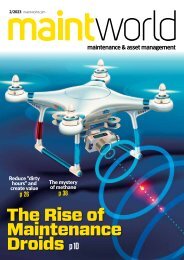Maintworld Magazine 4/2023
- maintenance & asset management
- maintenance & asset management
You also want an ePaper? Increase the reach of your titles
YUMPU automatically turns print PDFs into web optimized ePapers that Google loves.
PARTNER ARTICLE<br />
reliability while reducing downtime and<br />
maintenance costs. The contact sensors<br />
are ideal for continuous monitoring<br />
of critical assets like bearings, valves,<br />
steam traps, and hydraulic systems.<br />
In contrast, the airborne sensors,<br />
with varying IP ratings (IP65 and IP40),<br />
are tailored to accommodate the constraints<br />
of your specific environment,<br />
including inspecting electrical systems.<br />
In other words, they can be employed<br />
for monitoring assets suffering from abnormal<br />
friction, impact, and turbulence,<br />
which are telltale signs of distress or<br />
product quality issues. Whether you're<br />
monitoring the health of valves, steam<br />
traps, hydraulic systems, or even deploying<br />
ultrasound-driven lubrication, these<br />
sensors are your go-to solution.<br />
But the real beauty of CONMON-<br />
Sense sensors is their ability to be permanently<br />
installed on your most critical<br />
assets. For example, you can use CON-<br />
MONSense Airborne sensors to monitor<br />
potential partial discharge in electrical<br />
cabinets, adding a layer of safety and<br />
security to your operations.<br />
EXCEPTIONAL SIGNAL<br />
MEASUREMENT CAPABILITIES<br />
While the CONMONSense sensors<br />
share similarities with the SDT handheld<br />
device-compatible sensors, they<br />
stand out in terms of their signal measurement<br />
capabilities. The embedded<br />
electronics in the CONMONSense range<br />
enable advanced compatibility but have<br />
certain limitations when measuring<br />
weak signals. In cases where you need to<br />
acquire faint signals, sensors dedicated<br />
to SDT handheld instruments might be<br />
preferable, as they offer more capabilities<br />
in measuring weak signals.<br />
DISCOVER THE POWER OF<br />
ANALOG SENSORS<br />
Analog sensors are pivotal in industrial<br />
applications, as they capture and transmit<br />
information in the form of electrical<br />
signals. The CONMONSense sensors<br />
offer a range of popular analog outputs,<br />
including 4-20 mA, 0-10 V, and IEPE.<br />
These outputs are compatible with acquisition<br />
systems equipped with voltage<br />
and/or current channels, making them<br />
highly versatile and cost-effective.<br />
In industrial applications, electrical<br />
noise can be a significant concern. The<br />
4-20 mA output standard, embraced<br />
by the CONMONSense sensors, excels<br />
in such scenarios. Its high immunity to<br />
electrical noise ensures accurate and<br />
consistent readings over long distances,<br />
even in harsh industrial environments<br />
where other signal types may falter.<br />
TWO DISTINCT OUTPUT MODES:<br />
DYNAMIC (AC) AND STATIC (DC)<br />
CONMONSense sensors are designed<br />
to provide both dynamic (AC) and<br />
static (DC) output modes. The dynamic<br />
mode delivers a continuous signal<br />
that oscillates around a bias voltage<br />
(in the case of voltage output) or bias<br />
current (in the case of current output).<br />
This signal, sampled at a minimum<br />
rate of 10 kHz, can be further postprocessed<br />
and analyzed to extract<br />
valuable information about the health<br />
of the asset being monitored. Spectral<br />
transformation techniques such as<br />
FFT or envelope FFT can highlight the<br />
most prominent frequencies and their<br />
amplitudes in a signal. On the other<br />
hand, statistical indicators like RMS<br />
(Root Mean Square), Peak Value, and<br />
Crest Factor are employed for tracking<br />
trends and triggering alarms.<br />
In the static mode (DC output),<br />
CONMONSense sensors provide RMS<br />
values representing ultrasound energy<br />
in the band-pass frequency. While this<br />
mode doesn't offer the same level of<br />
detailed information as the dynamic<br />
mode, it is valuable for tracking changes<br />
and trends over an extended period,<br />
making it an excellent tool for proactive<br />
maintenance.<br />
SELECTING THE RIGHT SENSOR<br />
The choice between dynamic and<br />
static modes largely depends on your<br />
acquisition system's specifications and<br />
capabilities. A minimum sampling rate<br />
of 10 kHz is essential to avoid aliasing<br />
phenomenon and loss of information in<br />
the dynamic mode.<br />
THE BENEFITS OF THE CON-<br />
MONSENSE SENSORS RANGE<br />
They are numerous:<br />
• Ultrasound Measurement Simplified:<br />
Experience the easiest way to measure<br />
ultrasound signals, converted into<br />
audible form, and compatible with<br />
conventional acquisition systems.<br />
• Enhanced Efficiency: Real-time and<br />
accurate data provided by CON-<br />
MONSense sensors allow businesses<br />
to optimize processes, reduce waste,<br />
and enhance productivity.<br />
• Cost Savings: With affordability and<br />
extended compatibility, these sensors<br />
help organizations reduce operational<br />
costs and increase profitability.<br />
• Data-Driven Decision Making: These<br />
sensors provide valuable insights for<br />
informed decision-making and proactive<br />
maintenance strategies.<br />
• Scalability: With a complete range of<br />
options, CONMONSense sensors can<br />
easily integrate into existing systems,<br />
enabling scalable deployment across<br />
different industries and applications.<br />
• Simplified Implementation: Userfriendly<br />
interfaces and comprehensive<br />
documentation make installation<br />
and configuration a breeze, giving a<br />
"sixth sense" to your installations.<br />
In conclusion, SDT CONMONSense<br />
sensors are a technological marvel in the<br />
world of condition monitoring. Their advanced<br />
features, versatile design, and easy<br />
integration with existing systems make<br />
them a vital asset for organizations aiming<br />
to improve asset performance, reduce<br />
maintenance costs, and enhance reliability.<br />
The precision and consistency offered<br />
by these sensors empower you to take<br />
control of your assets' health and ensure<br />
the continued success of your operations.<br />
Download the CONMONSense Brochure<br />
by scanning the QR code below.<br />
4/<strong>2023</strong> maintworld 23








